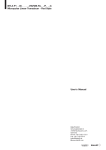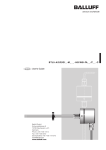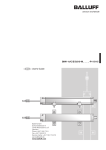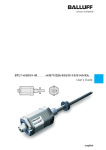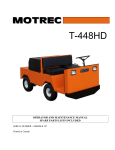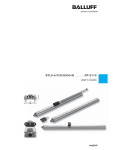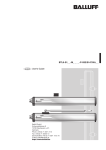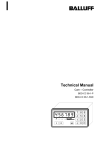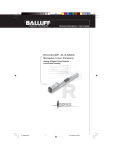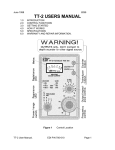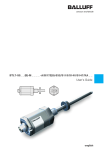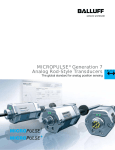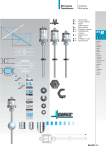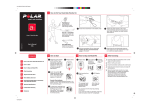Download User manual - Micropulse Linear Position Sensors
Transcript
BTL5-S1_ _-M_ _ _ _-HB/WB-FA_ _/F_ _-C Micropulse Linear Transducer - Rod Style User's Manual Balluff GmbH Schurwaldstraße 9 73765 Neuhausen a.d.F. Germany Phone +49 7158 173-0 Fax +49 7158 5010 [email protected] www.balluff.com english 1 BTL5-S1_ _-M_ _ _ _-HB/WB-FA_ _/F_ _-C Micropulse Linear Transducer - Rod Style Contents 1 1.1 1.2 1.3 1.4 1 Safety Advisory .................... 2 Proper application ................. 2 Qualified personnel ............... 2 Use and inspection ............... 2 Scope ..................................... 2 2 Function and Characteristics ..................... 3 2.1 Characteristics ...................... 3 2.2 Function ................................. 3 2.3 SSI interface .......................... 3 3 3.1 3.2 3.3 Installation ............................ 4 Mounting ................................ 5 Transducer, Installation ......... 5 Magnets, Installation ............. 6 4 Wiring .................................... 6 4.1 Cable axial and radial ........... 6 5 5.1 5.2 5.3 5.4 5.5 Startup .................................. 7 Check connections ................ 7 Turning on the system ........... 7 Check output values ............. 7 Check functionality ................ 7 Fault conditions ..................... 7 6 Versions (indicated on part label) .............................. 7 6.1 Included in shipment ............. 7 6.2 Available lengths ................... 7 7 7.1 7.2 7.3 Accessories .......................... 8 Magnets ................................. 8 Compatible devices .............. 8 Mounting nut .......................... 8 8 Technical Data ...................... 9 8.1 Dimensions, weights, ambient conditions ................ 9 8.2 Supply voltage (external) ....... 9 8.3 Control signals ....................... 9 8.4 Connection to processor ....... 9 2 english Safety Advisory Read this manual before installing and operating the Micropulse Transducer. 1.1 Proper application The BTL5 Micropulse transducer is intended to be installed in a machine or system. Together with a controller (PLC) or a processor it comprises a position measuring system and may only be used for this purpose. Unauthorized modifications and non-permitted usage will result in the loss of warranty and liability claims. 1.2 1.4 Scope This guide applies to the model BTL5-S1...-M...HB/WB... Micropulse transducer. An overview of the various models can be found in chapter 6 Versions (indicated on part label) on page 7. Qualified personnel This guide is intended for specialized personnel who will perform the installation and setup of the system. 1.3 ducer system. In particular, steps must be taken to ensure that should the transducer system become defective no hazards to persons or property can result. This includes the installation of additional safety limit switches, emergency shutoff switches and maintaining the permissible ambient conditions. Use and inspection The relevant safety regulations must be followed when using the trans- Note: For special versions, which are indicated by an -SA_ _ _ designation in the part number, other technical data may apply (affecting calibration, wiring, dimensions etc.). BTL5-S1_ _-M_ _ _ _-HB/WB-FA_ _/F_ _-C Micropulse Linear Transducer - Rod Style 2 Function and Characteristics 2.1 Characteristics 2.2 Micropulse transducers feature: – High data security: Output data are checked for validity and plausibility in the µC. – Very high resolution, repeatability and linearity – – Absolute output signal Measurement range monitoring with "Out of Range" Bit 221. Immunity to shock, vibration, and contamination Tough assembly Housing of stainless steel – – – – Wear- and maintenance-free measuring principle – Pressure rated to 600 bar – – Teflon cable Capability of connecting cable guard systems Enclosure rating per IEC 60529: Cable version IP 68 (type tested at 5 bar / 48 h) IP69/K with connected cable guard system – Function The transducer contains a tubular waveguide enclosed by an outer stainless steel rod. A magnet attached to the moving member of the machine or to the cylinder piston is moved over the rod and its position constantly updated. The magnet defines the measured position on the waveguide. An internally generated INIT pulse interacts with the magnetic field of the magnet to generate a magnetostrictive torsional wave in the waveguide which propagates at ultrasonic speed. The torsional wave arriving at the end of the waveguide is absorbed in the damping zone. The wave arriving at the beginning of the waveguide creates an electrical signal in the coil surrounding the waveguide. The corresponding value is output as synchronous serial data (SSI) via the RS 485/422 interface. This takes place with high precision and repeatability within the measuring range indicated as the nominal stroke length. The electrical connection between the transducer, the processor/controller and the power supply is via a cable. Dimensions for installing the Micropulse transducer: ➥ Fig. 3-1 Dimensions for installing the magnet: ➥ Fig. 3-4 2.3 SSI interface Depending on the BTL version, the SSI interface uses 24 or 25 bits and the position values are transmitted in Gray or binary code. The max. clock frequency t depends on the cable length ➥ section 8 Technical Data on page 9. For the purposes of error detection bit 221 is provided as an “Out of Range” message, ➥ Fig. 2-1 and Fig. 2-2. Sending of the position values is finished within time tm. It is started with the falling edge of the last clock pulse. After this time the BTL is ready for the next data transmission. At the rod end is a damping zone, within which no reliable signal is available, but which may be entered by the magnet. Clock sequence 1 2 3 4 23 24 t < tm tv = 150 ns +Clk t tm tv MSB +Data LSB Out of ➀ Range Fig. 2-1: Pulse diagram, example with 24 bit coding ➀ only for resolution > 5 µm tm = 31 µs measured with 1 m cable independent of the clock frequency The time t m starts with the falling edge of the last clock impulse (bit 24 or bit 25 depending on the version). Null point End point Position of magnet: 1) out of the measurement range 2) within the measurement range 3) magnet not present "Out of Range" Bit 221 will be set after the occurence of the event. Value of the output data 20 ... 220: 1a) 0 1b) max. at end point + 10 mm 2) proportional to distance 3) 0 Technical data are valid within the measurement range only, i.e. between null and end point. Fig. 2-2: Output data shown with "Out of Range" situation english 3 BTL5-S1_ _-M_ _ _ _-HB/WB-FA_ _/F_ _-C Micropulse Linear Transducer - Rod Style 3 Installation BTL5...HB/WB-...-C - axial Damping zone HB: 30 -1mm WB: 2" -0.04" ➀ Nom. length M18×1.5 = stroke ➀ Magnet ➁ Thread size HB: M18×1.5 WB: 3/4"-16UNF Ø 5 for Hookspanner Ø 58-62, tightening torque max. 100 Nm Blind hole M4×4/ 6 deep Mounting surface ➀ unusable area ➁ not included BTL5...HB/WB-...-C - radial Damping zone HB: 30 -1mm WB: 2" -0.04" Nom. length ➀ = stroke ➀ Magnet ➁ Blind hole M4×4/ 6 deep Mounting surface Fig. 3-1: Transducer BTL5-...HB/WB-..., Dimensions Important Installation Notes: The contact surface of the transducer must be completely contacted by the mounting surface. The O-ring supplied must make a perfect pressure seal, i.e. the bevel for the O-ring must be configured exactly as shown in Fig. 3-3. 4 english To achieve secure mounting, use the proper nut for the mounting thread. When tightening the transducer, do not exceed a tightening torque of 100 Nm. For horizontal mounting of transducer with stroke lengths greater than 500 mm, the pressure tube should be supported or attached at its end. When installing in a hydraulic cylinder, do not allow the magnet ring to rub against the pressure tube. The bore diameter in the piston and cylinder rod should be at least 13 mm. BTL5-S1_ _-M_ _ _ _-HB/WB-FA_ _/F_ _-C Micropulse Linear Transducer - Rod Style 3 Installation (cont.) 3.1 Mounting When possible, use non-magnetizable material for attaching the transducer and magnet ring. ➥ Fig. 3-2. When attaching the transducer to magnetizable materials, appropriate measures must be taken to protect against magnetic disturbances ➥ Fig. 3-2. Note the recommended distance of the transducer and cylinder from strong, external magnetic fields. non-magnetizable material ➀ - ➂ for magnetizable materials ➃ for non-magnetizable materials a = Spacer made of non-magnetizable materials b = Magnet Fig. 3-2: Mounting 3.2 Transducer, Installation The smallest permissible distance between magnet ring and rod mounting surface is shown in ➥ Fig. 3-1. Threaded hole M18×1.5 per ISO 6149 O-ring 15.4 × 2.1 The transducer has either a M18×1.5 thread or a 3/4"-16UNF thread for mounting. The sealing is carried cut with the O-ring supplied at the flange facing. Threaded hole 3/4"-16UNF per SAE J475 O-ring 15.3 × 2.4 Bevel for O-ring Threaded hole Fig. 3-3: Threaded hole for mounting the BTL with O-ring english 5 BTL5-S1_ _-M_ _ _ _-HB/WB-FA_ _/F_ _-C Micropulse Linear Transducer - Rod Style 3 Installation (cont.) 4 3.3 Magnets, Installation BTL-P-0814-GR-PAF A magnet is required for each transducer. This must be ordered separately. ➥ Fig. 3-4. Note the following when making electrical connections: System and control cabinet must be at the same ground potential. For mounting the magnet we recommend to use non-magnetizable material. ➥ Fig. 3-2. BTL-P-1013-4R Wiring (cont.) To ensure the electromagnetic compatibility (EMC) which Balluff warrants with the CE Mark, the following instructions must be strictly followed. BTL-P-1014-2R BTL-P-1012-4R BTL transducer and the processor/control must be connected using shielded cable. Shielding: Copper filament braided, 85 % coverage. The cable shield must be grounded on the control side, i.e., connected to the protection ground. Pin assignments can be found in ➥ Table 4-1. Connections on the controller side may vary according to the controller and configuration used. To avoid coupled noise, avoid proximity to high-current lines when routing cable between transducer, controller and power supply. Inductive coupled noise from AC harmonics (e.g., from phase controls) are especially critical, against which the cable shield offers very little protection. Fig. 3-4: Magnet (optional) 4 Wiring 4.1 Cable axial and radial Cable length max. 400 m; Ø 6 to 8 mm. Longer lengths may be used if construction, shielding and routing are such that external noise fields will have no effect on signal integrity. Caution! False data will result from reversing the +Clk and –Clk inputs. +Clk YE –Clk PK +Data GY –Data GN GND BU +24 V BN BTL5-S1_ _ Processor/ Controller Fig. 4-1: BTL5-S1_ _-... with Processor/Controller, connection example 6 english Colors BTL5-S1... Interface signals YE yellow +Clk PK pink -Clk GY gray +Data GN green –Data Supply voltage (external) BU blue GND BN brown +24 V WH white do not connect Table 4-1: Wiring BTL5-S1_ _-M_ _ _ _-HB/WB-FA_ _/F_ _-C Micropulse Linear Transducer - Rod Style 5 Startup 5.1 Check connections Although the connections are polarity reversal protected, components can be damaged by improper connections and overvoltage. Before you apply power, check the connections carefully. 5.2 Turning on the system Note that the system may execute uncontrolled movements when first turned on or when the transducer is part of a closed-loop system whose parameters have not yet been set. 6 Therefore make sure that no hazards could result from these situations. 5.3 Check output values After replacing or repairing a transducer, it is advisable to verify the values for the start and end position of the magnet in manual mode. If values other* than those present before the replacement or repair are found, a correction should be made. * Transducers are subject to modification or manufacturing tolerances. Check functionality The functionality of the transducer system and all its associated components should be regularly checked and recorded. 5.5 Fault conditions When there is evidence that the transducer system is not operating properly, it should be taken out of service and guarded against unauthorized use. Versions (indicated on part label) SSI interface Supply voltage: 1 = DC 24 V Electr. connection, BTL5-S102-M0450-HB-FA05-C Micropulse Linear Transducer 5.4 FA05: Teflon cable 5 m , axial F05: Teflon cable 5 m , radial C: For connection of cable guard system Rod Style, Mounting: HB = metric thread M18×1.5 WB = Thread 3/4"-16UNF Nom. length (4digits): M = metric in mm Resolution: 2 = 5 µm 7 = 2 µm Code: 24 bit 0 2 25 bit 6 8 6.1 = = = = binary, binary, binary, binary, 3 = 10 µm 8 = 50 µm 4 = 20 µm rising falling rising falling 1 3 7 9 = = = = Gray, Gray, Gray, Gray, 5 = 40 µm 6 = 100 µm rising falling rising falling Included in shipment Transducer with condensed guide 6.2 Available lengths Nominal stroke lengths of from 25 to 4000 mm are available for ideally sizing the transducer to the application. english 7 BTL5-S1_ _-M_ _ _ _-HB/WB-FA_ _/F_ _-C Micropulse Linear Transducer - Rod Style 7 Accessories (order separately) 7.1 Magnets Magnet BTL-P-1013-4R, BTL-P-1012-4R ➥ Fig. 3-4 Dimensions Weight approx. 10 g Housing anodized aluminum Operating temp. –40 °C to +85 °C included in shipment Spacer 8 mm Material POM (Polyoxymethylene) 8 english Magnet BTL-P-1014-2R ➥ Fig. 3-4 Dimensions Weight approx. 10 g Housing anodized aluminum Operating temp. –40 °C to +85 °C Magnet BTL-P-0814-GR-PAF ➥ Fig. 3-4 Dimensions Weight approx. 2 g Housing Polyamide bound ferrite Operating temp.–40 °C to +85 °C 7.2 Compatible devices Display: BDD-AM10-1-SSI display and limit controller with 2 relay outputs 7.3 Mounting nut BTL5...-HB... Mounting nut M18x1.5 BTL-A-FK01-E-M18x1.5 BTL5...-WB... Mounting nut 3/4"-16UNF BTL-A-FK01-E-3/4"-16UNF BTL5-S1_ _-M_ _ _ _-HB/WB-FA_ _/F_ _-C Micropulse Linear Transducer - Rod Style 8 Technical Data Typical values at DC 24 V, room temperature and BTL with nominal length of 500 mm. Ready for operation at once, full accuracy after warm-up. With magnet BTL-P-1013-4R, BTL-P-1014-2R or BTL-P-1012-4R: Non-linearity for resolution < 10 µm for resolution > 10 µm ± 30 µm ± 2 LSB Hysteresis < 1 LSB Repeatability < 2 LSB (resolution + hysteresis) Temperature coefficient < (6 µm + 5 ppm * nominal length)/K lag error 2.5 Frame Shock loading 100 g/6 ms per IEC 60068-2-27 1 Continuous shock 100 g/2 ms per IEC 60068-2-29 1 Vibration 12 g, 10 to 2000 Hz per IEC 60068-2-6 1 (take care to avoid inherent resonances of protective tube) Pressure up to 600 bar when installed in a hydraulic cylinder 1 Supply voltage (external) BTL5-...-FA05 with connecting cable, axial arrangement, 5 m long 8.3 Cable length < 25 m < 50 m < 100 m < 200 m < 400 m Control signals Interface RS 485/422 Clock input: +Clk, –Clk (via optical coupler) Clock frequency max. 1000 kHz Output data +Data, –Data Position information 24 or 25 bit serial Dimensions, weights, ambient conditions Nominal length Dimensions Weight Housing Pressure tube < 4000 mm ➥ Fig. 3-1 approx. 2 kg/m Stainless steel Stainless steel 1.4571 Diameter 10.2 mm Wall thickness 2 mm E-modulus approx. 200 kN/mm2 Mounting threads M18×1.5 or 3/4"-16UNF Operating temp. –40 °C to +85 °C Humidity < 90 %, non-dewing Protection rating per IEC 60529 with connector attached: cable version IP 68 (type tested at 5 bar / 48 h) IP69/K with connected cable guard system Connection to processor Regulated supply voltage BTL5-_1... 20 to 28 V DC < 0.5 Vpp Ripple Current draw < 90 mA < 3 A/0.5 ms Inrush Polarity reversal protection built-in Overvoltage protection Transzorb diodes Electric strength GND to housing 500 V DC Individual specifications as per Balluff factory standard 8.1 8.4 UL authorization File No. E227256 The CE Mark verifies that our products meet the requirements of EU Directive 2004/108/EC (EMC Directive) and the EMC Law. Testing in our EMC Laboratory, which is accredited by DATech for Testing Electromagnetic Compatibility, has confirmed that Balluff products meet the EMC requirements of the following Generic Standards: EN 61000-6-4 (emission) EN 61000-6-2 (noise immunity) BTL5-...-F05 with connecting cable, radial arrangement, 5 m long Teflon cable -40 °C to +200 °C The clock frequency is a function of the cable length: Clock frequency < 1000 kHz < 500 kHz < 400 kHz < 200 kHz < 100 kHz Table 8-1: Clock frequency The following patents have been granted in connection with this product: US Patent 5 923 164 Apparatus and Method for Automatically Tuning the Gain of an Amplifier Emission tests: RF Emission EN 55011 Group 1, Class A+B Noise immunity tests: Static electricity (ESD) EN 61000-4-2 Severity level 3 Electromagnetic fields (RFI) EN 61000-4-3 Severity level 3 Fast transients (Burst) EN 61000-4-4 Severity level 3 Surge EN 61000-4-5 Severity level 2 Line-induced noise induced by high-frequency fields EN 61000-4-6 Severity level 3 Magnetic fields EN 61000-4-8 Severity level 4 english No. 857 937 - 726 E • 00.000000 • Edition 0709; specifications subject to changes. 8.2 Resolution (LSB) depending on version: BTL5-S1 _2... 5 µm BTL5-S1 _3... 10 µm BTL5-S1 _4... 20 µm BTL5-S1 _5... 40 µm BTL5-S1 _6... 100 µm BTL5-S1 _7... 2 µm BTL5-S1 _8... 50 µm 9









